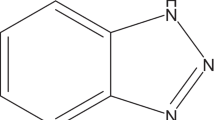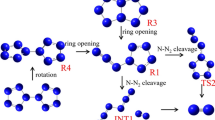Abstract
Two series of polynitro heterocyclic compounds with three conformations are designed based on the obtained dodecahydrodiimidazo [4,5-b:4′,5′-e]pyrazine “565” structure. First, the conformations including boat, chair, and plane, are optimized at B3PW91/6-311+G(d,p) level and some important properties are calculated. Based on the bond order, bond dissociation enthalpies and molecular energy analysis, it is found that the boat conformation owns lower energy and better bond order than the other two, and thus is most stable. Then, a further study on the electrical potential surfaces (EPS) proves that the stability of boat conformation can be contributed to the better balance between the positive and negative EPS. Next, according to molecular energy gap and density of state, the effect of each group on molecule is investigated: electrons on nitro group, compared with those on the framework, are easier to be activated so as to cause decomposition, thus nitro groups will determine the stability of molecule. Finally, the explosive velocity, pressure, and impact sensitivity of designed compounds are calculated. Results show that their explosive performances are significantly better than current energetic materials, and it is extraordinary enough that some compounds among them also maintain very good sensitivity.






Similar content being viewed by others
References
Thottempudi V, Shreeve JM (2011) Synthesis and promising properties of a new family of high-density energetic salts of 5-nitro-3-trinitromethyl-1H-1,2,4-triazole and 5,5′-bis(trinitromethyl)-3,3′-azo-1H-1,2,4-triazole. J Am Chem Soc 133:19982–19992
Fischer N, Fischer D, Klapötke TM, Piercey DG, Stierstorfer J (2012) Pushing the limits of energetic materials—the synthesis and characterization of dihydroxylammonium 5,5′-bistetrazole-1,1′-diolate. J Mater Chem 22:20418–20422
Wang PC, Zhu Z, Xu J, Zhao X, Lu M (2013) Theoretical study of the thermodynamic and burning properties of oxygen-rich hydrazine derivatives-green and powerful oxidants for energetic materials. J Mol Model 19:2583–2591
Pagoria PF, Lee GS, Mitchell AR, Schmidt RD (2002) A review of energetic materials synthesis. Thermochim Acta 384:187–204
Zhao GZ, Lu M (2013) Comparative theoretical studies of energetic dodecahydrodiimidazo[4,5-b:4′,5′-e]pyrazine derivatives. Comput Theor Chem 1007:57–62
Liu Y, Zhang L, Wang GX, Wang LJ, Gong XD (2012) First-principle studies on the pressure-induced structural changes in energetic ionic salt 3-azido-1,2,4-triazolium nitrate crystal. J Phys Chem C 116:16144–16153
Tan B, Long X, Li J (2012) The cage strain energies of high-energy compounds. Comput Theor Chem 993:66–72
Zhou H, Wong NB, Zhou G, Tian A (2006) Theoretical study on “multilayer” nitrogen cages. J Phys Chem A 110:3845–3852
Sharma H, Garg I, Dharamvir K, Jindal VK (2010) Structure of polynitrogen clusters encapsulated in C60: a density functional study. J Phys Chem C 114:9153–9160
Klapötke TM, Piercey DG, Stierstorfer J (2011) The Taming of CN7 −: the Azidotetrazolate 2-Oxide Anion. Chem Eur J 17:13068–13077
Gao H, Shreeve JM (2011) Azole-based energetic salts. Chem Rev 111:7377–7436
Wang F, Wang GX, Du HC, Zhang JY, Gong XD (2011) Theoretical studies on the heats of formation, detonation properties, and pyrolysis mechanisms of energetic cyclic nitramines. J Phys Chem A 115:13858–13864
Klapotke TM, Piercey DG, Stierstorfer J (2012) Amination of energetic anions: high-performing energetic materials. Dalton Trans 41:9451–9459
Srinivas D, Ghule VD, Muralidharan K (2014) Synthesis of nitrogen-rich imidazole, 1,2,4-triazole and tetrazole-based compounds. RSC Adv 4:7041–7051
Simpson RL, Urtiew PA, Ornellas DL, Moody GL, Scribner KJ, Hoffman DM (1997) CL-20 performance exceeds that of HMX and its sensitivity is moderate. Propell Explos Pyrot 22:249–255
Dong K, Wang Y, Gong XB, Zhang J, Sun CH, Pang SP (2013) Formyl azido substituted nitro hexaazaisowurtzitane—synthesis, characterization and energetic properties. New J Chem 37:3685–3691
Wilcox CF, Zhang YX, Bauer SH (2000) The thermochemistry of TNAZ (1,3,3-trinitroazetidine) and related species: models for calculating heats of formation. J Mol Struct 528:95–109
Xu XJ, Xiao HM, Xiao JJ, Zhu W, Huang H, Li JS (2006) Molecular dynamics simulations for pure ε-CL-20 and ε-CL-20-Based PBXs. J Phys Chem B 110:7203–7207
Wu Q, Zhu W, Xiao H (2014) Computer-aided design of two novel and super-high energy cage explosives: dodecanitrohexaprismane and hexanitrohexaazaprismane. RSC Adv 4:3789–3797
Bushuyev OS, Brown P, Maiti A, Gee RH, Peterson GR, Weeks BL, Hope-Weeks LJ (2011) Ionic polymers as a new structural motif for high-energy-density materials. J Am Chem Soc 134:1422–1425
Frisch MJ, Trucks GW, Schlegel HB, Scuseria GE, Robb MA, Cheeseman JR, Scalmani G, Barone V, Mennucci B, Petersson GA, Nakatsuji H, Caricato M, Li X, Hratchian HP, Izmaylov AF, Bloino J, Zheng G, Sonnenberg JL, Hada M, Ehara M, Toyota K, Fukuda R, Hasegawa J, Ishida M, Nakajima T, Honda Y, Kitao O, Nakai H, Vreven T, Montgomery JA Jr, Peralta JE, Ogliaro F, Bearpark MJ, Heyd JJ, Brothers E, Kudin KN, Staroverov VN, Kobayashi R, Normand J, Raghavachari K, Rendell A, Burant JC, Iyengar SS, Tomasi J, Cossi M, Rega N, Millam JM, Klene M, Knox JE, Cross JB, Bakken V, Adamo C, Jaramillo J, Gomperts R, Stratmann RE, Yazyev O, Austin AJ, Cammi R, Pomelli C, Ochterski JW, Martin RL, Morokuma K, Zakrzewski VG, Voth GA, Salvador P, Dannenberg JJ, Dapprich S, Daniels AD, Farkas O, Foresman JB, Ortiz JV, Cioslowski J, Fox DJ (2003) Gaussian 03. Gaussian Inc., Pittsburgh
Becke AD (1992) Density-functional thermochemistry. II. The effect of the Perdew–Wang generalized-gradient correlation correction. J Chem Phys 97:9173–9177
Becke AD (1993) A new mixing of Hartree–Fock and local density-functional theories. J Chem Phys 98:1372–1377
Miehlich B, Savin A, Stoll H, Preuss H (1989) Results obtained with the correlation energy density functionals of becke and Lee, Yang and Parr. Chem Phys Lett 157:200–206
Lee C, Yang W, Parr RG (1988) Development of the Colle-Salvetti correlation-energy formula into a functional of the electron density. Phys Rev B 37:785–789
Politzer P, Martinez J, Murray JS, Concha MC, Toro-Labbé A (2009) An electrostatic interaction correction for improved crystal density prediction. Mol Phys 107:2095–2101
Politzer P, Martinez J, Murray JS, Concha MC (2010) An electrostatic correction for improved crystal density predictions of energetic ionic compounds. Mol Phys 108:1391–1396
Wiberg KB, Ochterski JW (1997) Comparison of different ab initio theoretical models for calculating isodesmic reaction energies for small ring and related compounds. J Comput Chem 18:108–114
Wiberg KB, Rablen PR (1993) Comparison of atomic charges derived via different procedures. J Comput Chem 14:1504–1518
Blanksby SJ, Ellison GB (2003) Bond dissociation energies of organic molecules. Acc Chem Res 36:255–263
Yao XQ, Hou XJ, Jiao H, Xiang HW, Li YW (2003) Accurate calculations of bond dissociation enthalpies with density functional methods. J Phys Chem A 107:9991–9996
Stewart JJP (1989) Optimization of parameters for semiempirical methods I. Method. J Comput Chem 10:209–220
Kamlet MJ, Jacobs SJ (1968) Chemistry of detonations. I. A simple method for calculating detonation properties of C–H–N–O explosives. J Chem Phys 48:23–35
Pospíšil M, Vávra P, Concha M, Murray J, Politzer P (2010) A possible crystal volume factor in the impact sensitivities of some energetic compounds. J Mol Model 16:895–901
Hammerl A, Klapötke TM, Nöth H, Warchhold M, Holl G (2003) Synthesis, structure, molecular orbital and valence bond calculations for tetrazole azide, CHN7. Propell Explos Pyrot 28:165–173
Lu T, Chen F (2012) Multiwfn: a multifunctional wavefunction analyzer. J Comput Chem 33:580–592
Lu T, Chen F (2012) Quantitative analysis of molecular surface based on improved marching tetrahedra algorithm. J Mol Graph Model 38:314–323
Acknowledgments
We thank National Natural Science Foundation of China (No: 51374131) for support of this research.
Author information
Authors and Affiliations
Corresponding author
Rights and permissions
About this article
Cite this article
Li, Q.H., Wang, P.C. & Lu, M. The importance of molecular conformation to the properties: a DFT study of the polynitro heterocyclic compounds based on dodecahydrodiimidazo [4,5-b:4′,5′-e]pyrazine structure. Struct Chem 26, 667–674 (2015). https://doi.org/10.1007/s11224-014-0524-1
Received:
Accepted:
Published:
Issue Date:
DOI: https://doi.org/10.1007/s11224-014-0524-1




